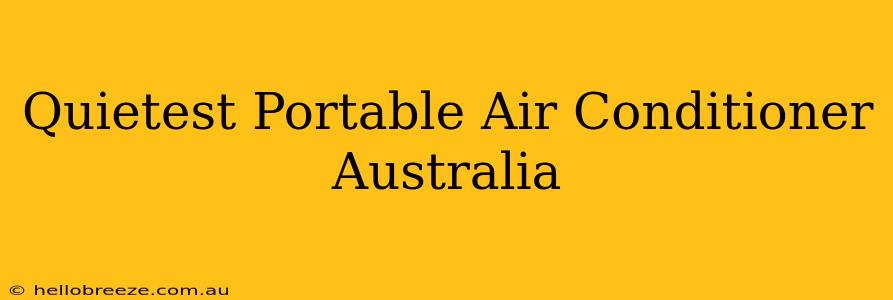Summer in Australia can be brutal. Finding the right portable air conditioner is crucial for staying cool, but the relentless drone of some units can be a major drawback. This guide explores the quietest portable air conditioners available in Australia, helping you find the perfect balance of cooling power and peaceful operation.
Understanding Noise Levels in Portable Air Conditioners
Before diving into specific models, it's important to understand how noise levels are measured. Portable air conditioners typically express noise output in decibels (dB). The lower the dB rating, the quieter the unit. A general guideline:
- Below 45 dB: Considered very quiet, almost silent. Ideal for bedrooms and sensitive environments.
- 45-55 dB: Quiet operation, suitable for most rooms.
- 55-65 dB: Moderate noise level. Might be noticeable but not overly disruptive.
- Above 65 dB: Loud operation. Can be distracting and unsuitable for bedrooms or quiet spaces.
Remember that these are general guidelines, and the actual perceived noise can vary depending on your environment and the unit's operating mode.
Top Picks for Quiet Portable Air Conditioners in Australia
Finding a truly "silent" portable air conditioner is challenging, but several models stand out for their quiet operation. When researching, always check the manufacturer's specifications for the dB rating. Look for features such as:
- Variable speed fans: Allow you to adjust the airflow and noise level to your preference.
- Sleep mode: Often reduces fan speed and noise during nighttime use.
- Eco mode: Prioritizes energy efficiency, which frequently results in quieter operation.
While specific models change frequently (new ones appear and older ones are discontinued), here are some features and brands to look for when searching for a quiet portable air conditioner in Australia:
Factors to Consider Beyond Noise Level:
- Cooling Capacity (BTU): This determines how effectively the unit can cool a room. Match the BTU rating to the size of the room you intend to cool. Larger rooms will require higher BTU units.
- Energy Efficiency: Look for units with a high energy efficiency rating (EER) to minimize your electricity bills.
- Features: Consider extra features like dehumidification, timers, and remote controls.
- Size and Portability: Ensure the unit is compact enough to fit through doorways and easily maneuvered.
- Installation: While portable, some units require a hose to vent hot air outside, affecting placement.
Where to Find the Quietest Models:
Check major Australian retailers like Harvey Norman, JB Hi-Fi, Good Guys, and Bing Lee. You'll find extensive reviews and compare prices before committing to a purchase. Reading customer reviews will provide valuable insights into real-world noise levels.
Maintaining Quiet Operation
Even the quietest portable air conditioner can become noisy if not properly maintained. Regular cleaning and filter changes are essential for optimal performance and quieter operation. A clogged filter restricts airflow, forcing the unit to work harder and potentially generating more noise.
Conclusion: Cool Down Without the Noise
Choosing a quiet portable air conditioner for your Australian home doesn't have to be a compromise. By understanding noise levels, considering key features, and reading reviews, you can find the perfect balance of cooling power and peaceful comfort. Remember to prioritize energy efficiency and regular maintenance to keep your unit running smoothly and quietly for years to come.

